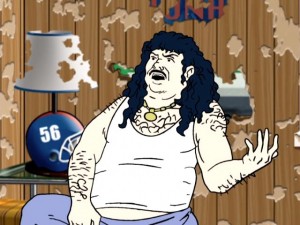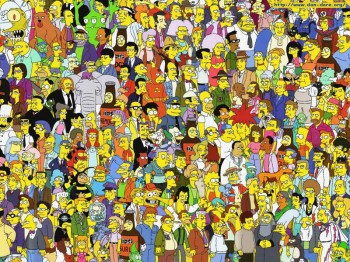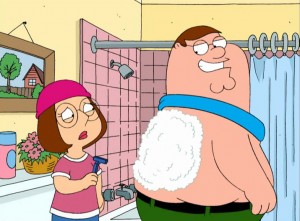Animation &Commentary 30 Apr 2007 08:02 am
Blum Commentary
- I read an editorial in an April 10th issue of The NYSun, and thought I’d put all of the attention of today’s blog into it. Normally, I wouldn’t put up an entire piece like this, but what the hell? I like it, and I don’t want it go completely unnoticed.
The commentary is by David Blum and is called
. . . . . . . . . . . . . . . . . . . . . “Who’s Laughing Now?”
- Is it genuinely funny to see an animated, overweight, middle-aged dude on a living room couch, waiting for the chorus of the “Maude” theme song to kick in? To me it’s mildly amusing, but I don’t think I’m supposed to be the target audience for Fox’s “The Family Guy,” where that reference turned up on a recent episode. Very few 12-year-olds have a working knowledge of theme songs from 1970s sitcoms, and those who do need to get into something more useful, like stamp collecting. But this is what happens when you entrust the writing of prime-time cartoons to adults. They write what they know. And if you’ve ever met a Hollywood television comedy writer, you know that most of them grew up with baby sitters named Sony and Panavision.
 It’s not fair that so many jokes on television’s most popular cartoons don’t work for people who don’t shave. That’s the target audience, and who Hollywood hopes to attract by turning these cartoons into movies themselves — “The Simpsons” movie opens in July, and the Cartoon Network’s “Aqua Teen Hunger Force” full-length version arrives in theaters this Friday. Maybe a few smart kids will get these shows’ highbrow allusions to movies like “The Natural” and “2001: A Space Odyssey,” but most preteens don’t get these nods to the past, and their parents don’t do much more than note them and nod off.
It’s not fair that so many jokes on television’s most popular cartoons don’t work for people who don’t shave. That’s the target audience, and who Hollywood hopes to attract by turning these cartoons into movies themselves — “The Simpsons” movie opens in July, and the Cartoon Network’s “Aqua Teen Hunger Force” full-length version arrives in theaters this Friday. Maybe a few smart kids will get these shows’ highbrow allusions to movies like “The Natural” and “2001: A Space Odyssey,” but most preteens don’t get these nods to the past, and their parents don’t do much more than note them and nod off.
Okay, so I was home as a kid watching memorable movies and sitcoms, too, and I get the gags on “Family Guy” — most of them, anyway. But they’re more likely to make me wince at my vast, unnecessary knowledge of trivia than laugh at the repetition. A single episode contains so much material culled from television that it’s impossible to keep track of it all; one random episode included mentions of “dingo and the baby” (an homage to the 1988 Meryl Streep movie, “A Cry in the Dark), “Masturbator & Commander” (after the Russell Crowe movie “Master & Commander”), and an ice-cream-and-punishment sequence lifted directly from the 1980 Academy Award-winning movie, “Kramer vs. Kramer.”
There’s so much material in “Family Guy” taken from elsewhere that it inspired ridicule on an episode of “South Park,” in which the show’s writers were portrayed as manatees getting their joke notions from “idea balls” spinning freely in a giant bin.
 The writers at “The Simpsons” aim higher than “Family Guy,” but sometimes end up in the same place — with lines that resonate more with memory than humor. “As God is my witness,” Homer Simpson declares in one episode as he begins a new diet, “I’ll always be hungry again!” Is that funny, or is it just familiar? I don’t think there’s all that much entertainment value in a television version of Trivial Pursuit, and that’s what television cartoons have largely become — a catalog of lines from old movies, theme songs from 1960s sitcoms, and mentions of actors like David Hasselhoff. I’m probably the only person in my ZIP code to catch the “Simpsons” reference to Fox’s 1991 sitcom trainwreck “Herman’s Head,” and that’s not a proud moment.
The writers at “The Simpsons” aim higher than “Family Guy,” but sometimes end up in the same place — with lines that resonate more with memory than humor. “As God is my witness,” Homer Simpson declares in one episode as he begins a new diet, “I’ll always be hungry again!” Is that funny, or is it just familiar? I don’t think there’s all that much entertainment value in a television version of Trivial Pursuit, and that’s what television cartoons have largely become — a catalog of lines from old movies, theme songs from 1960s sitcoms, and mentions of actors like David Hasselhoff. I’m probably the only person in my ZIP code to catch the “Simpsons” reference to Fox’s 1991 sitcom trainwreck “Herman’s Head,” and that’s not a proud moment.
The cannibalizing of the actual classics will result in another, more pernicious effect in the years to come — taking away the pleasure for kids of seeing the original source material from which great lines and memorable scenes are taken. When the latest generation of preteen cartoon-watchers grows up and sees the horse’s head sequence from “The Godfather,” they’ll have the implanted memory of the “Simpsons” episode in which Bart found the head of the Jebediah Springfield statue in his bed. Won’t that reduce the shock value, later in life, of seeing John Marley wake up to the sight of his silk bedsheets drenched in blood? The entire “Treehouse of Horror V” episode functions as a parody of “The Shining,” a movie most “Simpsons” fans won’t see for years. All references and no jokes make “The Simpsons” a dull show.
 This isn’t meant as a broadside against “The Simpsons,” which even at its weakest spins its thievery with wit and remains one of television’s finest achievements. And “Family Guy,” for all its dependence on cultural references and quotations, manages to be funny much of the time. It’s just that when the references become as tired as they’ve grown lately — “Family Guy” has, most recently, been borrowing from the comedy stylings of Carol Burnett, who has reciprocated by suing — you start to wonder about the point. Even more troubling than the trend itself may be the prospects for the future of cartoons. What will be left for the animated-comedy writers of tomorrow to borrow? At least this generation had some good material to use. Given the current scarcity of classic movies, it’s not implausible to imagine cartoons of the future stealing from Stewie Griffin of “Family Guy” or channeling Homer Simpson for their scripts. Will our children’s children find that funny? I seriously doubt it.
This isn’t meant as a broadside against “The Simpsons,” which even at its weakest spins its thievery with wit and remains one of television’s finest achievements. And “Family Guy,” for all its dependence on cultural references and quotations, manages to be funny much of the time. It’s just that when the references become as tired as they’ve grown lately — “Family Guy” has, most recently, been borrowing from the comedy stylings of Carol Burnett, who has reciprocated by suing — you start to wonder about the point. Even more troubling than the trend itself may be the prospects for the future of cartoons. What will be left for the animated-comedy writers of tomorrow to borrow? At least this generation had some good material to use. Given the current scarcity of classic movies, it’s not implausible to imagine cartoons of the future stealing from Stewie Griffin of “Family Guy” or channeling Homer Simpson for their scripts. Will our children’s children find that funny? I seriously doubt it.
– Don’t miss Mark Kennedy‘s blog, Temple of the Seven Golden Camels. Today, it features Ken Anderson‘s African sketchbooks.
Anderson was a Disney artist/designer most of his life. He was one of the old-time animation guys who used real life for his inspiration, not other cartoons or television shows. He was something of a Renaissance man for Disney.

